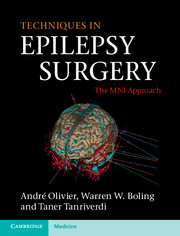Book contents
- Frontmatter
- Contents
- Acknowledgment
- Preface
- 1 History of epilepsy surgery
- 2 The search for the epileptic focus: investigation of the surgical candidate
- 3 Surgical anatomy
- 4 Neuronavigation and preoperative brain mapping
- 5 Stereoelectroencephalography (stereotactic intracranial recording)
- 6 Anesthesia and awake procedure
- 7 Peroperative brain mapping
- 8 Endopial resection (intervascular endopial gyral emptying)
- 9 Surgery of temporal lobe epilepsy: cortico-amygdalohippocampectomy
- 10 Surgery of temporal lobe epilepsy: transcortical selective amygdalohippocampectomy
- 11 Surgery of central area epilepsy
- 12 Surgery of frontal lobe epilepsy
- 13 Surgery of parietal lobe epilepsy
- 14 Surgery of insular lobe epilepsy
- 15 Surgery of occipital lobe epilepsy
- 16 Hemispherectomy
- 17 Callosotomy
- 18 Epilepsy and brain tumors
- 19 Surgical treatment of cortical dysplasias
- 20 Reoperations in failed epilepsy surgery
- 21 Alternative procedures in surgery for epilepsy
- 22 Complications of epilepsy surgery
- 23 Quality of life after epilepsy surgery
- Index
- References
22 - Complications of epilepsy surgery
Published online by Cambridge University Press: 05 October 2012
- Frontmatter
- Contents
- Acknowledgment
- Preface
- 1 History of epilepsy surgery
- 2 The search for the epileptic focus: investigation of the surgical candidate
- 3 Surgical anatomy
- 4 Neuronavigation and preoperative brain mapping
- 5 Stereoelectroencephalography (stereotactic intracranial recording)
- 6 Anesthesia and awake procedure
- 7 Peroperative brain mapping
- 8 Endopial resection (intervascular endopial gyral emptying)
- 9 Surgery of temporal lobe epilepsy: cortico-amygdalohippocampectomy
- 10 Surgery of temporal lobe epilepsy: transcortical selective amygdalohippocampectomy
- 11 Surgery of central area epilepsy
- 12 Surgery of frontal lobe epilepsy
- 13 Surgery of parietal lobe epilepsy
- 14 Surgery of insular lobe epilepsy
- 15 Surgery of occipital lobe epilepsy
- 16 Hemispherectomy
- 17 Callosotomy
- 18 Epilepsy and brain tumors
- 19 Surgical treatment of cortical dysplasias
- 20 Reoperations in failed epilepsy surgery
- 21 Alternative procedures in surgery for epilepsy
- 22 Complications of epilepsy surgery
- 23 Quality of life after epilepsy surgery
- Index
- References
Summary
Introduction
Although epilepsy surgery is safe and effective, it is not free of complications. This type of surgery shows some peculiarities that are not common in other neurosurgical procedures. A unique feature is that removal or disconnection of functionally normal brain areas are often an essential part of surgical strategy, which may lead to functional deficits. Furthermore, patients prior to undergoing surgery frequently require invasive diagnostic procedures in order to lateralize and/or localize the epileptic focus, adding to the risk of complications. Potential complications from both invasive diagnostic and surgical treatment should be well recognized and the surgeon must inform the patient, family members, or caregivers. Although a low morbidity is reported for epilepsy surgery, a complication such as intracranial hemorrhage or direct injury to a highly functional area can be catastrophic and overshadow an otherwise successful surgery.
Definition of a complication
There is no universal definition of a complication after epilepsy surgery but based on a few previously published reports we have defined a complication as an unwanted, unexpected, and uncommon event after either a diagnostic or therapeutic procedure. In this chapter, the severity of surgical and neurological complications following surgery is graded as minor if transient and of no significant functional impact or major if causing significant disability that can be permanent. However, it should be noted that the definition of a complication is open for discussion because some postoperative disturbances may be considered acceptable side effects and not complications if they resolve completely within a few days. For example, brain edema may cause simple transient side effects such as dysphasia or mild hemiparesis that generally resolves after anti-edema medication and passage of time. Furthermore, a permanent or temporary visual (upper quadrantanopia) field defect should not be classified as a complication, because it may be unavoidable in temporal lobe surgery. In the same context, homonymous hemianopsia after occipital lobe resection is not a complication since the deficit would have been discussed in detail with the patient prior to surgery and would be expected after surgery. An expected paresis after a functional tissue removal in the sensorimotor area should not be considered a complication.
- Type
- Chapter
- Information
- Techniques in Epilepsy SurgeryThe MNI Approach, pp. 269 - 276Publisher: Cambridge University PressPrint publication year: 2012



